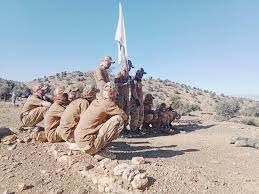Jabhat Ansar al-Mahdi Khorasan: A Distinct Threat
By: Riccardo Valle; The Khorasan Diary

Background
The militant landscape of Pakistan is becoming more complex due to the emergence of several new, small, and highly capable militant groups. They are largely connected to two umbrella organizations, the Tehreek-e-Taliban Pakistan (TTP) and Hafiz Gul Bahadur (HGB).
While HGB includes many subgroups, Jabhat Ansar al-Mahdi Khorasan (JAMK) quickly rose to prominence thanks to its dedication to forming a proper media entity tasked with methodically claiming attacks. JAMK releases videos and statements from the group’s leadership, in contrast with the reclusive leaders of HGB.
The militant landscape of Pakistan is becoming more complex due to the emergence of several new, small, and highly capable militant groups. These groups ostensibly act as independent entities and claim to admire the Afghan Taliban’s model of a jihadist group that effectively transitioned from insurgency to a de facto government. However, they maintain that their fight is solely confined to Pakistan, where they seek to enforce sharia.
These groups include Tehreek-e-Jihad Pakistan (TJP), Ansarul Jihad (AuJ), Majlis-e-Askari, Jaish-e-Fursan-e-Muhammad, Jabhat al-Junud al-Mahdi (headed by Amir Sufiyan), and Jabhat Ansar al-Mahdi Khorasan (JAMK). Their links with their parent organizations—the Tehreek-e-Taliban Pakistan (TTP) and Hafiz Gul Bahadur (HGB, named after its founder and current leader)—have been disclosed by the militants themselves, their own modalities, and their patterns of attack (The Khorasan Diary, July 13, 2023). They are, therefore, anything but independent.
Jabhat Ansar al-Mahdi Khorasan’s Activities and Significance
JAMK first emerged quietly in late 2022, but in 2023 the group started to consistently claim attacks targeting Pakistan’s security forces, especially in the Bannu District of Khyber Pakhtunkhwa Province (X/@SaleemMehsud, February 14, 2023). The group is part of the broader HGB organization and constitutes one of its main factions. It is vital to situate the emergence of JAMK—as well as all newly formed militant groups—in the environment that arose after the US withdrawal from Afghanistan on August 15, 2021. After the Taliban seized power, Jihadist militant groups carefully balanced their objective of creating an ideologically driven “Islamic” proto-state with the policies of the Taliban’s Afghan Interim Government (AIG), which both sheltered the groups and restrained them (Dawn, July 10, 2023). In Afghanistan, militants can gain access to modern weapons, but acquiring them is difficult and is monitored by the Afghan Taliban.
Conversely, JAMK was born in a progressively expanding area of cooperation between different militant groups, such as the TTP and HGB. This trend has been endorsed by external militant entities, such as al-Qaeda and its local branch, al-Qaeda in the Indian Subcontinent (AQIS). Since late 2023, this cooperation has expanded to include coordinated attacks by the TTP and Tehreek-e-Lashkar-e-Islam Pakistan (TLIP). The group has conducted most of its attacks in the Bannu District, particularly the areas of Jani Khel and Baka Khel (X/@SaleemMehsud, June 16, 2023). The group has also disclosed that it carried out attacks in Lakki Marwat District, Khyber Pakhtunkhwa Province, in May 2023. This confirms it has the capability to launch attacks in multiple neighboring districts (The Khorasan Diary, February 14).
While HGB includes many subgroups, JAMK quickly rose to prominence thanks to its dedication to forming a proper media entity tasked with methodically claiming attacks. JAMK also releases videos and statements from the group’s leadership. This starkly contrasts with HGB, which has remained media-shy and avoided public attention.
JAMK’s Leadership
JAMK is headed by Commander Sadiqullah, who is from the Wazir tribe of the Baka Khel Area of Bannu District. There is no deputy emir of the group. However, every year, the group selects new individuals for several departments of the group, which is similar to the TTP. Among other vital figures, Maulvi Umar Mansoor Haqqani is in charge of the group’s military operations. According to JAMK spokesman Zubair Waziristani, the group includes five sections: the al-Nusra Department, the Institute of Research and Publication, the Department of War, the Department of Intelligence, and the Central Shura.
The media arm of the group is called al-Mansoor Media. On November 21, 2023, Zubair Waziristani officially inaugurated the media arm by releasing the official logo and sharing more videos and claims of attacks by JAMK. Previously, videos from the group featured mid-level commanders, such as Mawlana Abid Waziristani. However, after November 21, the group published a video series that imitated those produced by the TTP, such as one series dedicated to the al-Badr Battalion suicide squad.
The first JAMK-claimed suicide attack followed this uptick in media activities. On November 26, 2023, the group declared that one of its militants bombed a Pakistan Army convoy in the Baka Khel Area of Bannu District, killing two nearby civilians and wounding ten other people (Dawn, November 27, 2023). Since the start of the new year, JAMK has claimed eight other attacks, primarily against surveillance cameras and security forces on patrol in the Jani Khel and Baka Khel areas of Bannu District.
Conclusion
The potential threat posed by JAMK rests in its ability to carry out unpredictable suicide attacks against security forces in an area where both the TTP and HGB operate. Moreover, shortly after the November 26, 2023, attack, Pakistan formally asked the AIG to hand over Hafiz Gul Bahadur himself, who is allegedly residing in the southern Afghan provinces of Paktika and Khost. Pakistan also noted that the suicide attacker was identified as an Afghan national, which is consistent with Pakistan’s allegations that the TTP, TJP, and HGB are deploying Afghan nationals in suicide operations. JAMK and HGB pose a threat to Pakistan, but they also risk disturbing Pakistan’s bilateral relations with Afghanistan and contributing to the destabilization of the South Asian region.
Source: Jamestown.org, March 22, 2024
